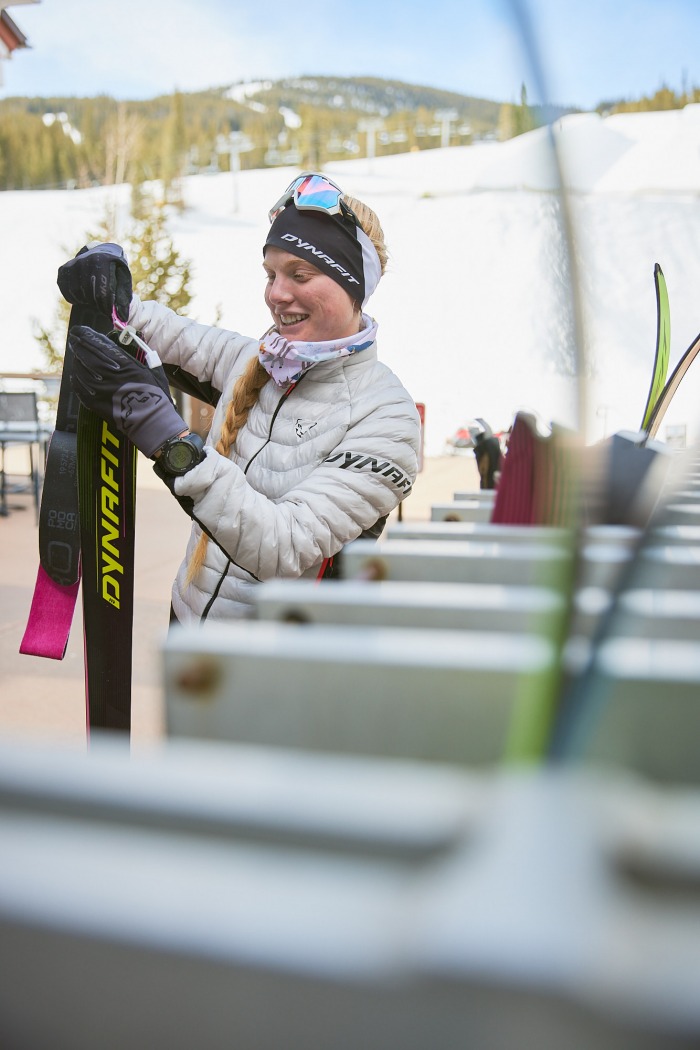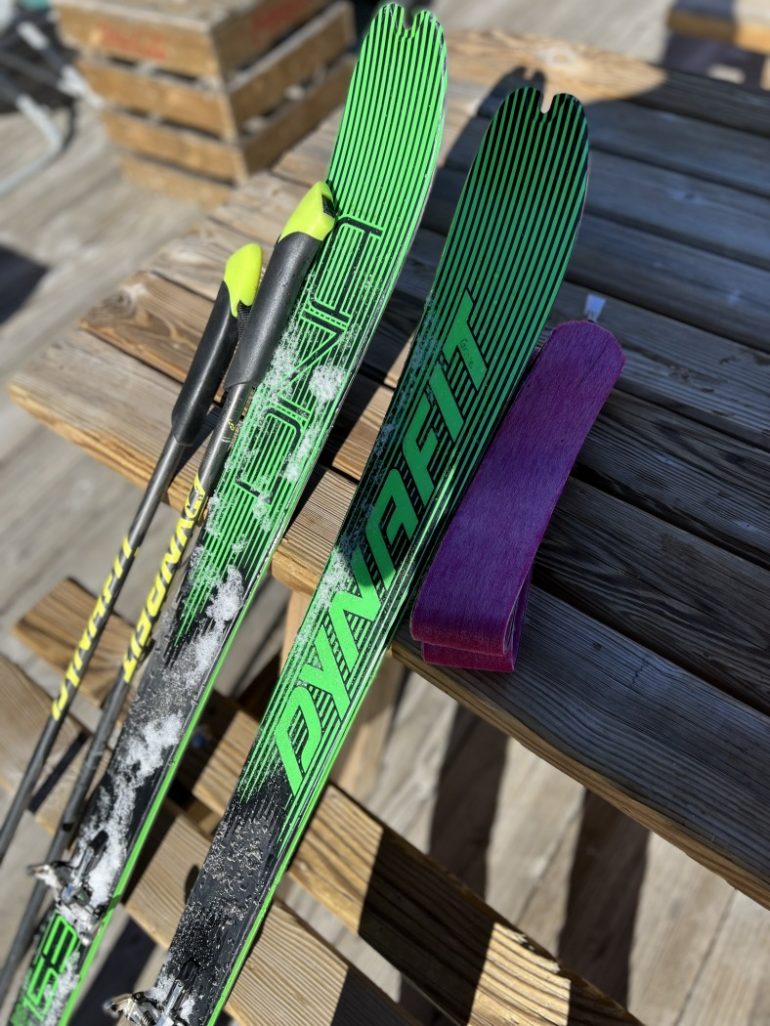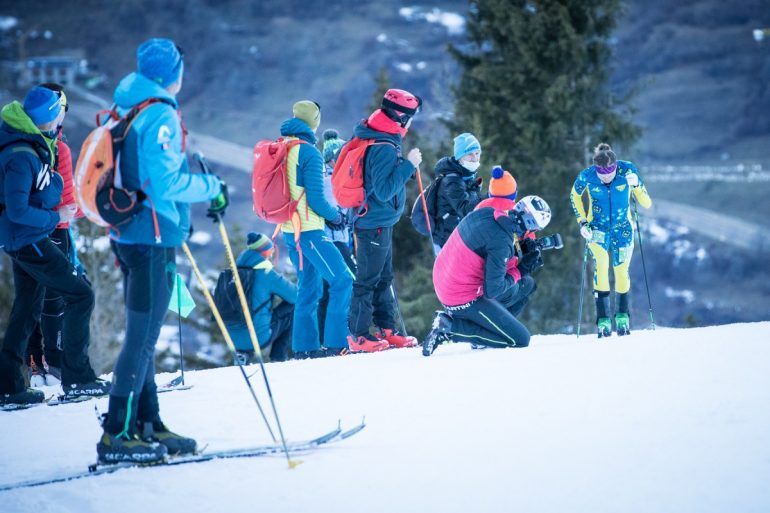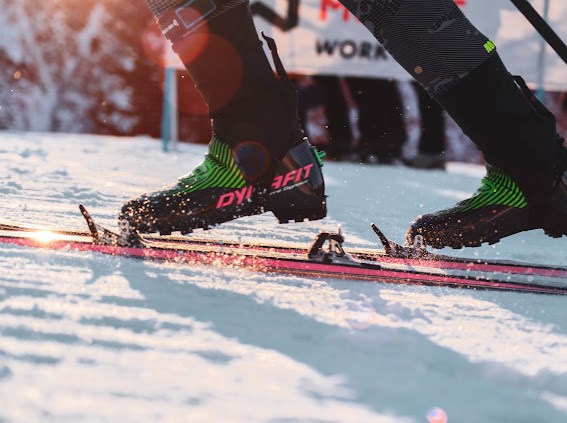
The author during a chill moment on the race scene. Photo: Andrew Maguire / andrew-maguire.com.
This weekend the ISMF World Cup resumes in Andorra. Info for live streaming the races can be found here. If you are interested in streaming replays of last month’s World Cup, here’s a link.
Most of you would likely scoff at me if I ever so much as implied that skimo race gear could be fun. Not only for the uphill touring portion, where a weight reduction is almost guaranteed to increase the fun factor, but for the actual skiing portion as well. I’ve managed almost to forget what I’m missing at times thanks to an appreciation for the simple fact that the faster you can climb, the more meters you inevitably get to ski.
And who could be unhappy about more powder laps? Or, as the early 2022 predominate European trend, more skiing in the rain.
In all seriousness, race gear has come an incredibly long way in recent years and is becoming undeniably more competent in the mountains. Quick disclosure, I’m sponsored by Dynafit, CAMP USA and Pomoca, and may be a bit biased on the brand front. These are all brands I would support whether I was sponsored or not: I’m only willing to race in gear that I trust and love and am grateful to work with brands I’m passionate about.
Skimo racing is becoming increasingly popular, and with that, there’s an increasing demand- albeit modest- for race gear. But living in Europe, something that’s been striking to me is the amount of race gear you see out on the skintrack for a broad demographic of people. Alongside racers you’ll find families, older gentlemen who know more about the development of the carbon boots they’re wearing than you ever will and the classic Weekend Warrior. The presence of the “light and fast” gear category isn’t limited to racers. Or race situations. That said, certain pieces of race gear certainly cannot help but sacrifice some comfort (and “fun” factor on powder days) in the relentless pursuit of being as fast as possible.

A svellte pair of World Cup ready race Dynafit DNA Skis (153s) skis, and Pomoca Race Pro 2.0 Skins .
Take my race ski of choice, the Dynafit DNA, which weighs 700 grams and is a mere 65mm underfoot and 153cm long. The tiny skis are outfitted with a minimalist Low Tech Race 105 binding that makes heel risers obsolete for racing, in part because they’re combined with a boot featuring a massive range of motion. Due to a change in the ISMF race regulations for the 2021-2022 season, brakes are now mandatory, making them slightly heavier than beforehand. The lightest binding on the market: The Dynafit Pintech, or P49, weighs a mere 49 grams but cannot be fitted to a brake and therefore cannot be used on the World Cup stage. In terms of skis and bindings, look at any highly competitive start line, and you will find a variety of brands vying for position: Dynafit, Hagan, Ski Trab, Atomic, Voile, Salomon, the list goes on.
The “less is more” approach certainly goes beyond skis and bindings into the realm of ski boots, though frankly even calling the footwear racers don “ski boots” feels generous at times. Per race regulations set out by the ISMF, boots must contain two locking systems and extend at least above the ankle in height. Beyond that, anything is fair game. My own race weapon of choice is the Dynafit DNA by Pierre Gignoux,a full carbon boot in the same category as the Scarpa Alien 4.0, La Sportiva Stratos V, and Pierre Gignoux Race 400 or Race Pro. For a small weight sacrifice of grams, and a large benefit to your wallet, find the slightly heavier category of race boots including the Dynafit PDG, La Sportiva Raceborg, Scarpa Alien 1.0 and Atomic Backland. The cost of gear can certainly be a barrier to entry in our sport and not jumping straight into a full-carbon set-up can be one one to cut costs if you’re willing to sacrifice a few grams. Do your research, and figure out which components of a race boot are most important to you.
You’d think that with skis, bindings and boots squared away, you’d be set to head to the start line (or the skintrack). But, the race kit doesn’t end there. There’s the trademark skimo racer spandex that is likely to garner comments from the chairlift as you skin up the resort. Race suits may look a bit funky, but they’re highly functional for racing. Personally, I find them highly functional for training, allowing me to stuff pastries, gadgets like my phone/beacon/camera, and more into my easily accessible chest pockets. Race suits are breathable, easy to move in, and offer some wind protection. My one complaint, as a woman you better be confident that you can make it the length of your race or tour without needing to use the restroom unless you’d like to fully strip in the skintrack.

The ISMF places tight regs on minimum weight for ski setups. The scales do not lie. Pictured here is a Dynafit DNA race ski with the P49 Binding (no longer allowed in ISMF competition because it is incompatible with ski brakes). Photo: skimostats.com.
It’s also important to make sure that you have proper layering and apparel strategies. The weather can change on a dime and body temperature regulation is key when you’re both ascending and descending. I find it helpful to have a lightweight training top to climb in (the Mezzalama Race Jacket is a great choice) and I often put a vest and a heavier down layer in my pack for the descent. The key is to limit the amount you’re sweating on the climb, then keep warm enough while descending that you’re happy to put skins back on and climb again. In a similar vein, while I race in the lightweight Dynafit DNA gloves I often carry overmits or a slightly heavier pair of gloves, such as the Mercury Dynastretch, in my pack.
Next up on the gear docket, the non-apparel racing necessities. The first to deserve honorable mention is the race pack, a compact and highly streamlined backpack that manages to fit required gear without impeding the “light and fast” goal. In most races, safety gear like a protective wind layer, avalanche equipment, and a survival blanket are required – racers must find a backpack that works for them while fitting the required gear. Race packs also have an efficient ski attachment system that allows racers to put skis on their pack and bootpack without ever removing the backpack. Clearly, a huge timesaver compared to other ski touring packs. And a function some backcountry-oriented packs have adopted for those looking for some efficiencies while transitioning.

A skier ascends amidst the crowd during last month’s vertical reace on there ISMF World Cup. Photo: Maurizio Torri.
The race suit may have a reputation for looking a bit dorky, but most race helmets are equally as deserving of that label. Per ISMF regulations, race helmets must be dual certified for both mountaineering and alpine skiing. They may look a bit like an awkwardly placed egg atop racers’ heads, but the safety component outweighs the matter. More often than not, skimo race gear trends heavily towards “function over fashion”. Luckily, there are plenty of options from the Dynafit DNA helmet to other Dual Certified options.
Finally, there are a few key extras when we discuss race gear, among them: poles, eyewear and skins. Poles follow the trends of skis, boots and bindings; they are as light as possible. I am 5’7” and choose to race with a carbon Dynafit DNA pole cut to 135cm in length. Proper pole length can make a tremendous difference in races like the Grand Traverse, or on a more flat World Cup course, where skating is necessary. The trick is finding the balance for each individual between poles short enough that you can still grip and the top while descending, allowing you to wear pole straps to avoid losing one or both of them, and long enough that you can increase the ease of going uphill as much as possible. Eyewear is another highly individualized choice, with individuals donning products from Julbo, Smith, Oakley, and more.

The boots are all carbon. Not exaclty a slipper, there’s support for skiing, but they feel feather light.
Skin choice is often highly individualized and deserves an article of its own, as the proper skins for the day depend upon snow conditions, temperature and objectives. For example, if I know the snow is going to be warm and provide good glide and my objective for the day is speed, I will likely choose a pair of 59mm Pomoca Race Pro 2.0 Skins which are 100% mohair with low plush density and backing material. On the other hand, if I know the snow on a particular day will be slicker, the slope will be more aggressive, or I care less about speed, I may choose a pair of 62mm Pomoca Grip Skins. These too fall under Pomoca’s “Race” category and provide higher traction despite remaining 100% mohair. While the pure mohair skins are popular for racing, skins that are a 70/30 blend of mohair and nylon glide better than pure nylon, but are able to shed water better than pure mohair, making them a great middle-of-the-road option. Other popular skin brands in the race arena include Colltex, Contour, and Hagan.
The race gear conversation boils down to two questions: what will get you up (and down) the skintrack fastest? Do your own research, talk with friends from the skintrack, or consult with skimo shops like Skimo CO, Cripple Creek Backcountry, Jagged Edge Mountaineering, or my local favorite, Mountain Outfitters Breck; that’s the first step in exploring the silver linings of the ultra-light skimo race gear.
A World Cup Race Bag
-DNA 16 pack by Dynafit: 16L and 240 grams.
-Skins (Pomoca Race Pro 2.0, Race Pro Grip, or Race Pro 2.0 Vertical based on conditions. For all races I carry 2 pairs of skins with me, in the chest pockets of my suit, while racing).
-Passport (World Cups have an “identity document” as required gear).
-Avalanche Gear: Pieps Micro BT Sensor Beacon, CAMP Crest Shovel, Carbon 280+ PFA Ortovox Probe.
-Emergency Blanket.
-3rd layer for the top and 2nd layer for the bottom (your baselayer and race suit both count as layers). I carry the DNA race wind jacket and DNA race wind pants in my pack.
-Flask with Skratch Superfuel (depending on race length, if greater than 90 minutes).
-In Team Races, or races that are longer or in more consequential terrain, the following may be necessary and/or required: climbing harness, via Ferrata, crampons, and a headlamp.
-Whistle (fixed onto pack).
-And, the gear I wear: Dynafit DNA boot by Pierre Gignoux, Dynafit DNA helmet, a US National Team race suit (competitors race World Cups in their nation’s suit) or the Dynafit DNA race suit, Oakley Wind Jacket 2.0 glasses, Dynafit headband, Dynafit DNA gloves and in COVID times a KN95 mask.
Grace Staberg grew up in Silverthorne, Colorado and races both domestically and internationally as a trail runner and skimo athlete. She races the ISMF Skimo World Cup circuit in the winter, and when not racing, can be found on long adventures in the mountains. She is the North American Record Holder for most vertical feet ascended in 24-hours and enjoys nothing more than a good sufferfest. Alongside athletic goals, she is studying Economics and Finance at the London School of Economics. Grace is also passionate about mental health advocacy, mentorship of young athletes in sport and helping others to find as much joy and gratitude in the mountains as she does.
